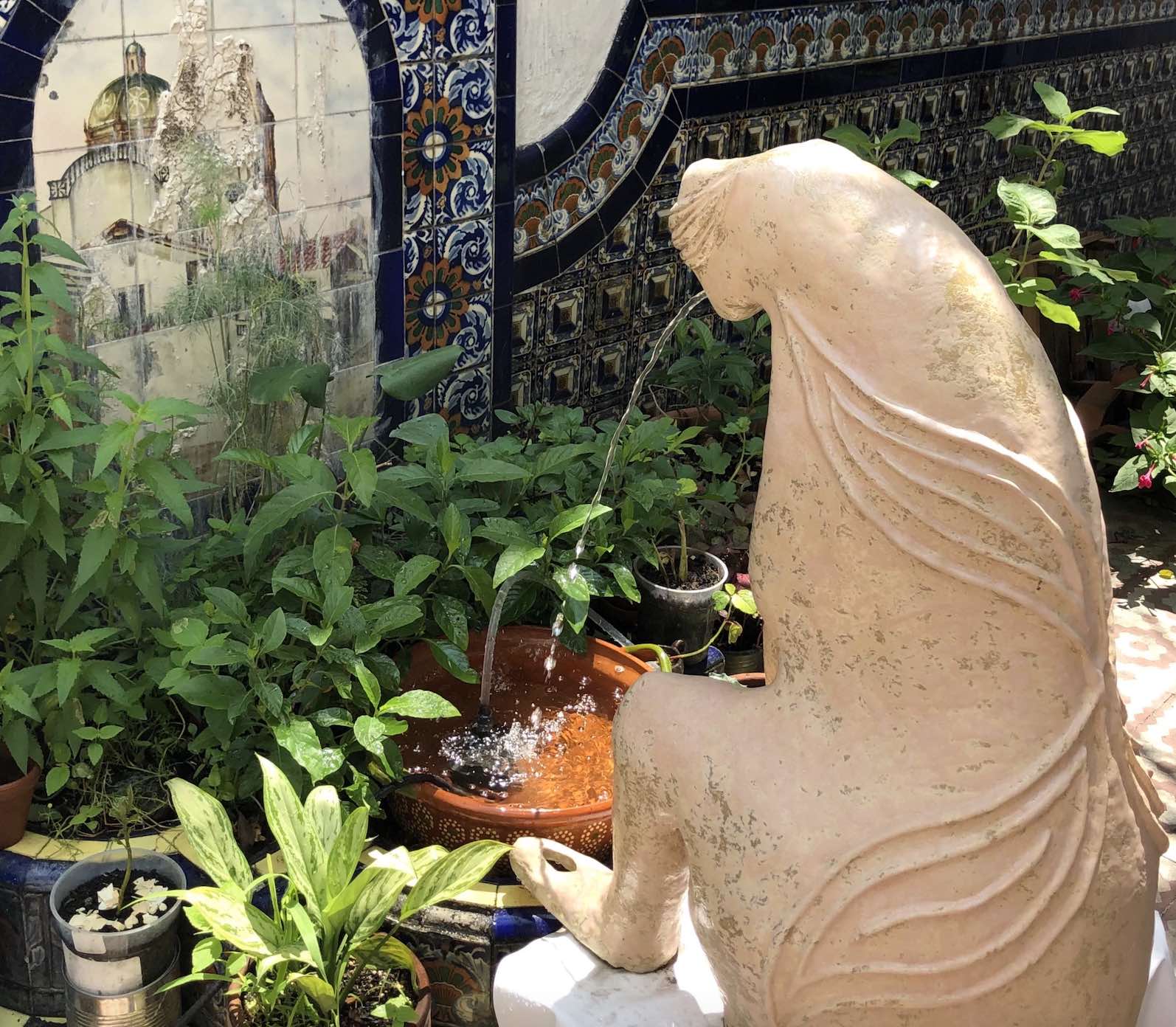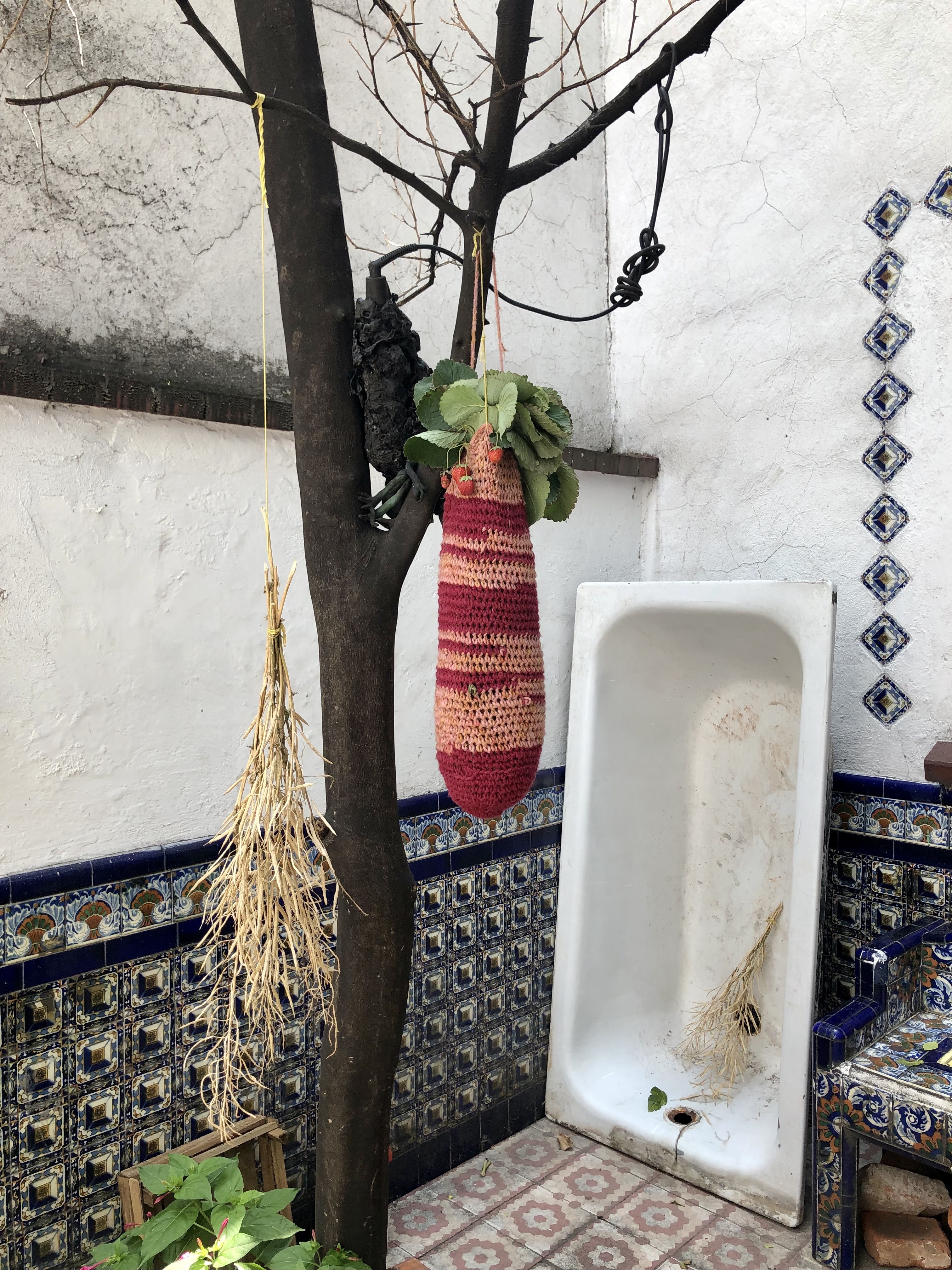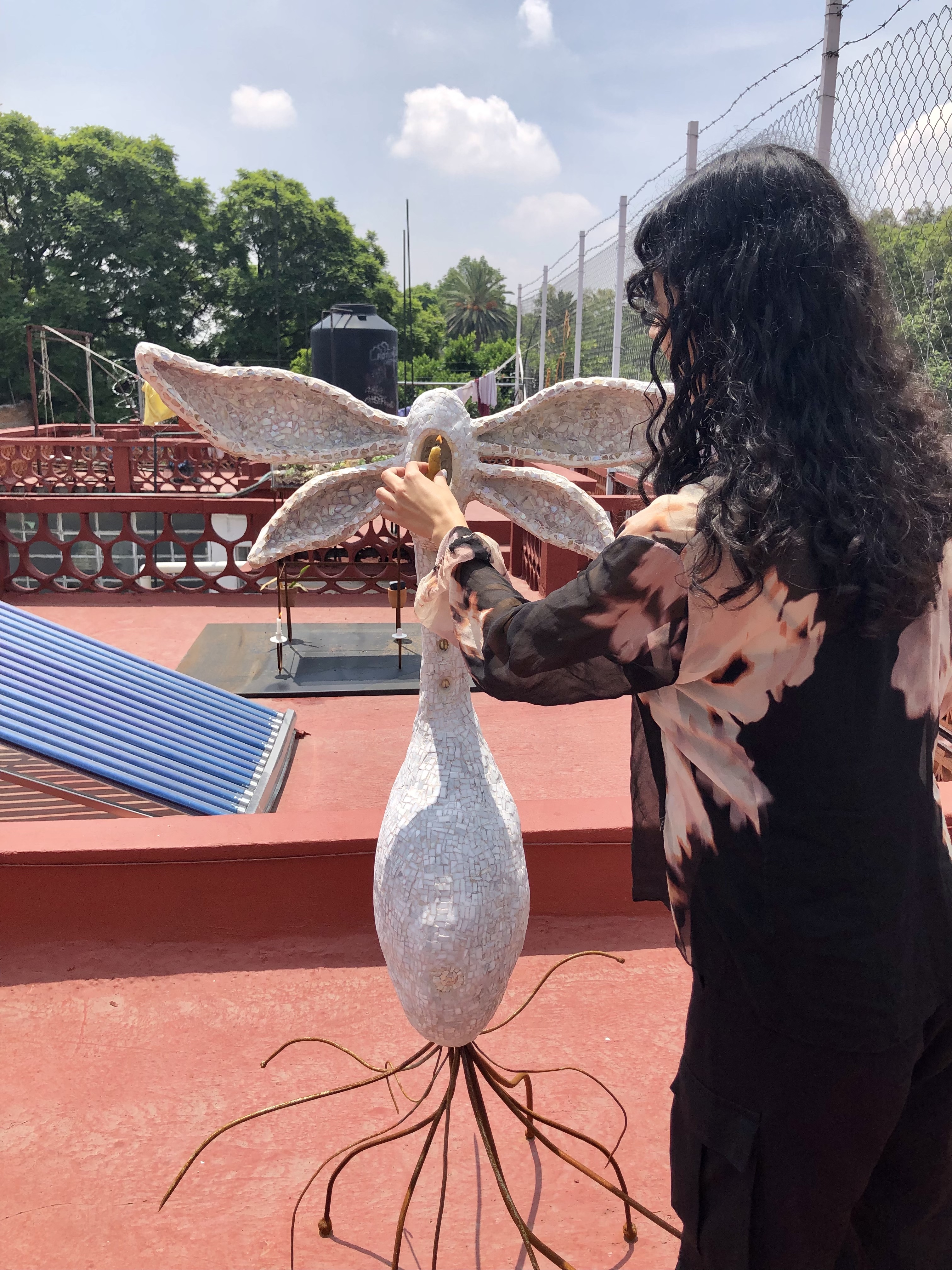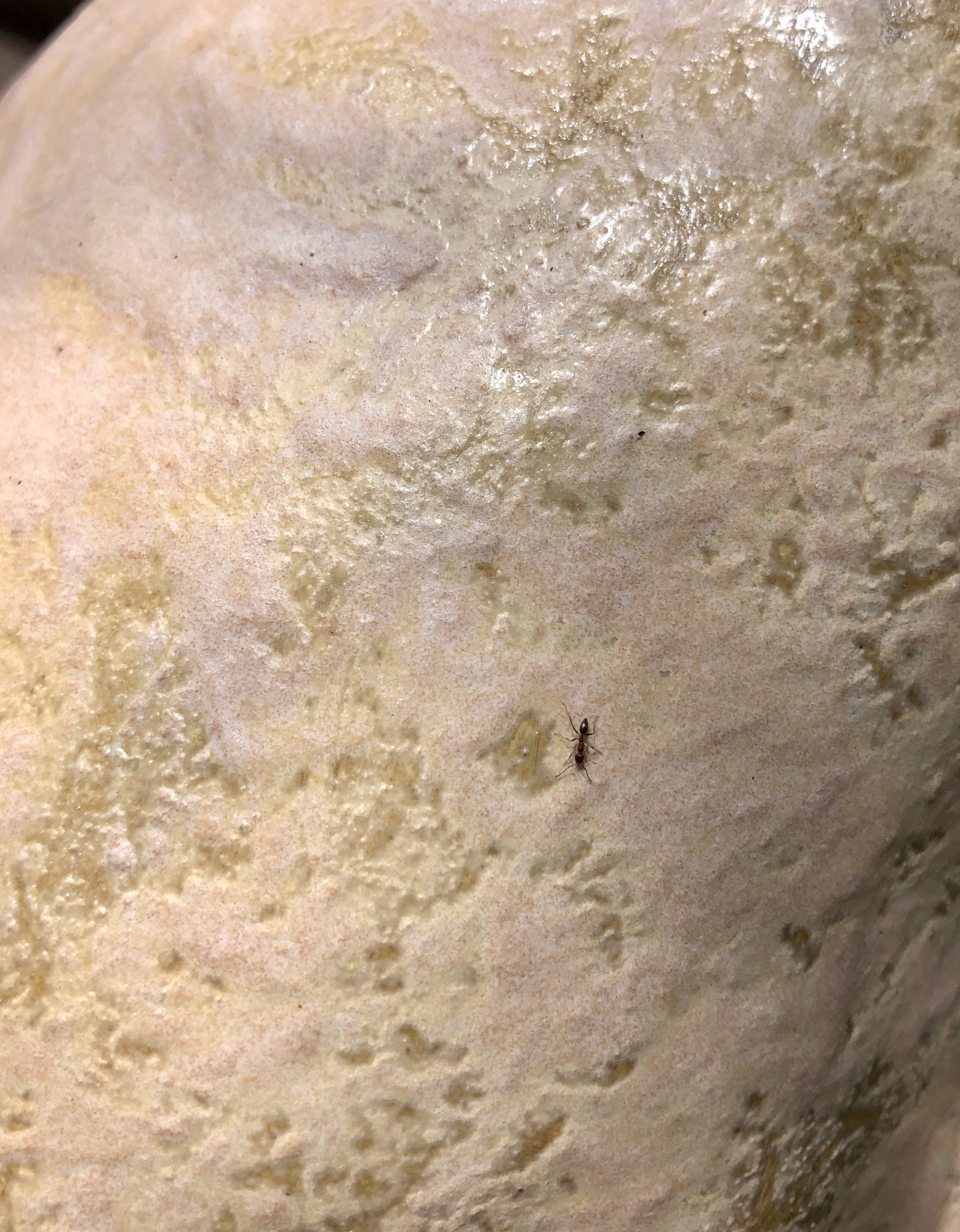
Review
Life to After-life and Reincarnated life:* On the Exhibition Selva Lunar (Lunar Jungle) at Biquini Wax EPS
by Mariel Vela
"You can cry or spit if you want"
Reading time
6 min
You can cry or spit if you want. I find myself leaning over one of the terrariums, studying its humidity in captivity. With Digestive Playground, María Huerta offers a collective accumulation of human fluids among ecosystems created within receptacles of glass and steel. The whole room smells like wet soil, an odor made of teardrops, saliva, and water, all settled over days. A tiny green stem peeks out among the stones, and I wonder what the most fertilizing fluid will be: the most appropriate vehicle for recognizing this encounter, in order to dissolve a part of me among others’ debris. I feel embarrassed; I don’t do anything, even though Carolina has gone to the patio, perhaps to leave me my privacy.
Through speculative fiction as well as scientific and cultural investigations, the exhibition Selva Lunar (Lunar Jungle) presents the multidisciplinary practices of Babak Ahteshamipour, Ylia Bravo Varela, and Daniel Robles Lizano. Meanwhile, the accompaniment of Carolina Vélez Muñiz, part of the curatorial platform éteres, manifests a cultivation system logic whereby the multiple and the random can proliferate. Since its opening, actions around the exhibition have been carried out by Nicolás Graham, Jimena García Álvarez Buylla, María Huerta, Fernanda Dichi, Luis Fernando Amaya, Sandra Mancilla, Cooperativa Simbiosis, and Alberto Montes Zarate, among others. These are actions that, within the humid and warm environs of Biquini Wax EPS, have become ferments advancing on the surface of Selva Lunar.

I like to see you at night, like an intuition that peeks out from the darkness. Emerging from a seed as big as a speck of dust, writes Jimena García Álvarez-Buylla in a letter to her Buddleja cordata shrub. In elementary school I placed three beans on a bed of cotton and awaited the mystery of their growth. Every morning I would go to look at the glass and see the inert, wet seeds, until the day came when the green peeked out, breaking the bean’s bluish surface. That newborn curve produced in me a devotion similar to that I felt for so many other things: the snails I kept in my desk, a potato decorated with buttons and yarn, a mechanical pencil with pink feathers. Any posthumanist would like to create those ecosystems produced in childhood, with that inseparability between organic and non-organic lives. Putting into practice that unbridled love that waters the flower until inundating it, that places a blanket over the plastic animal. When the bean plant developed sufficiently, I tried growing it in my home garden. The same garden where a hamster and two turtles were buried.
The house’s ground floor functions as a laboratory where relationships, plant literature, and crops can be generated. Or perhaps a garden? There is the Máquina Biótica [Biotic Machine] with pink mushroom crops emerging from the straw substrate, as well as fennel, camomile, lemon balm, hibiscus, mint, orange trees, strawberries, lemongrass, fava beans, quelites, and other types of beans. Black ants crawl up the spine of a blind creature, bent over the fountain. It provides the gift of clear water coming out of its mouth.

In the back there’s a river* in the damp room. It looks like the water of oblivion of Lethe, one of the rivers of Hades. The headphone cord is short, obliging me to watch the currents very closely and listen to que (no) te cubras de sombra [cover yourself with shadow (or not)], by Luis Fernando Amaya, as well as fragments extracted from the Huehuetlatolli, Sor Juana Inés de la Cruz, and letters by Carlota of Belgium, read out via the voices of loved ones. It seems that human voices are being dragged, stretched until they become something akin to whale songs: fragments that have returned from the future as distorted archives.
Carolina Vélez, who has accompanied me on the tour, begins climbing the stairs. I follow her and together we make the pilgrimage upwards, just like the ants advancing along the wall on a vertical path, just like the Cotyledon breaking its seed. We reach the surface of a red moon, waterproof, where there is a terrarium of different coexisting species: corals woven by Ylia Bravo Varela, succulents, ceramics. The sound piece by Babak Ahteshamipour is a combination of dripping and cavernous sounds contrasting with the sunny rooftop setting. Daniel Robles Lizano’s creatures shimmer in the sun and camouflage themselves in earthly forms in order to disguise their extraterrestrial presence: as flowers, tongues, mollusks, worms, beetles. A candle burns inside the mouth of one of them, the one with pieces of mother-of-pearl shell inside its petals, perhaps in order to capture solar energy. I also see that it has developed a system for harvesting rainwater and that it is pregnant.

An orchid of greenish metals adorns Carolina’s neck. I surreptitiously watch her as she tells me about El Salar, in southwestern Bolivia. Together with the neighboring Atacama regions of Chile and Argentina, it contains approximately 70% of the world’s lithium reserves. When volcanoes would roam the plains freely, Tunupa, the only female volcano, gave birth. The male volcanoes stole her baby and banished her to a faraway place. Tunupa cried unendingly; from her tears and her breast milk the salt lake known as Salar de Uyuni was created. As Liam Young and Kate Davies would say, “your smart-phone runs on the tears and breast milk of a volcano.”*
The ant that previously walked alone on the creature’s spine has summoned further ants that use it as a bridge for reaching the surrounding vegetation. What if no one moved it for a hundred years? It would be covered in green, things would grow on it: like old cell phones, plastic toys, toothbrushes. I ask about the compost, hoping to have a luminous image with which to close this chronicle of my tour. Talking about a speckled banana whose existence is energy broth,* of utopias, of humus, something in the spirit of Donna Haraway.
I discovered that the ants ate the earthworms.

* A phrase that appears in a video piece by Babak Ahteshamipour.
* Visuals by Román Cadafalch (@uno_cosechando)
* Kate Davies and Liam Young, Tales from the Dark Side of the City: The Breastmilk of the Volcano Bolivia and the Atacama Desert Expedition (London: Unknown Fields, 2016). https://anatomyof.ai/
* Brenda Hillman, “Practice of Talking to Plants.” Revista de la Universidad de México,
https://www.revistadelauniversidad.mx/articles/aa27608d-a6cb-4784-9ff9-26f7049b9396/poemas.
Translated to English by Byron Davies
Published on July 7 2022